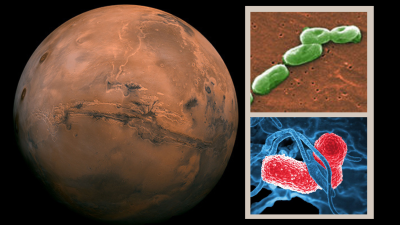Context
In space missions from Earth to other planetary bodies, planetary protection involves the critical goal of safeguarding both Earth's biosphere and that of the destination body from contamination by "alien" microbial life.
Overview
On September 5, China announced it would advance the timeline for its ambitious Mars sample-return mission, Tianwen-3, to 2028, potentially ahead of the U.S. During the announcement, the mission’s designer stated that it would adhere to the principles of planetary protection.
Planetary protection principle
- It is a crucial principle for interplanetary missions, such as those from Earth to the Moon or Mars. This principle is based on the idea that we should preserve the planetary biosphere in its "pristine" state, avoiding any "corruption" from influences that might arise due to the space mission.
- The principle is legally grounded in Article IX of the Outer Space Treaty (1967), which stipulates that parties must conduct outer space exploration while preventing "harmful contamination" and "adverse changes" to both Earth's and the celestial body's environments caused by the "introduction of extraterrestrial matter."
Harmful contamination from space
- Harmful contamination from space" refers to the introduction of extraterrestrial materials or microorganisms into Earth's or other celestial bodies' environments, which can potentially disrupt or damage local ecosystems.
- Example: Consider a spacecraft returning from Mars with samples of Martian soil and rocks. If these samples contain unknown microbes or chemicals not previously found on Earth, and they are not adequately contained, there is a risk they could be released into the environment upon arrival. This release could lead to unintended ecological impacts, such as the spread of alien
microbes that might interact unpredictably with Earth’s biosphere, potentially disrupting ecosystems or posing health risks to humans.
The way to clean the space craft
To meet planetary protection standards, spacecraft are cleaned through a rigorous process. One common method involves fully assembling the spacecraft and then subjecting it to a high-temperature takeout in a dry environment. This typically involves heating the spacecraft to 120 degrees Celsius for several days. This procedure helps to eliminate microbial contaminants and ensures that the spacecraft does not carry any unwanted biological material that could compromise the integrity of the planetary environment or biospheres it encounters.
The potential threats of extraterrestrial microbes on Earth include:
- Ecological Disruption: Alien microbes could interact with Earth's ecosystems in unpredictable ways, potentially outcompeting native microorganisms, disrupting food chains, or altering nutrient cycles, which could lead to significant environmental changes.
- Health Risks: These microbes might pose health threats to humans if they carry unknown pathogens or toxins, potentially causing new diseases or infections for which there are no existing treatments or vaccines.
- Agricultural Impact: Extraterrestrial microbes could affect plants, potentially damaging crops and agricultural systems. This could result in reduced agricultural productivity, food shortages, and economic repercussions.
- Biochemical Reactions: Alien microbes might introduce new biochemical processes or substances that interact with Earth's natural chemistry, possibly leading to harmful chemical reactions or environmental contamination.
- Evolutionary Consequences: The presence of extraterrestrial microbes could influence the evolution of Earth's microorganisms, potentially causing unforeseen changes in microbial communities and their interactions with each other and their environments.
Way ahead
- Enhanced Sterilization Techniques: Developing more effective and cost-efficient sterilization methods for spacecraft and equipment is crucial. This includes exploring advanced heat treatments, chemical sterilants, and innovative decontamination technologies.
- Improved Containment Protocols: Designing and implementing robust containment systems for handling extraterrestrial samples can prevent accidental contamination. This involves creating secure, controlled environments for analyzing samples and adhering to stringent safety procedures.
- Comprehensive Monitoring and Detection: Investing in advanced technologies for monitoring and detecting contaminants can help identify potential threats early. This includes developing sensitive instruments capable of detecting trace amounts of biological material.
- International Collaboration and Standards: Strengthening global cooperation and establishing unified planetary protection standards can enhance contamination prevention efforts. This involves sharing best practices, research findings, and technological advancements among spacefaring nations.
- Ongoing Research and Risk Assessment: Continuously researching the risks associated with extraterrestrial microbes and refining risk assessment models can lead to more effective protection strategies. This includes studying the potential impacts of alien microorganisms on Earth’s ecosystems and human health.
- Public Awareness and Education: Increasing public understanding of planetary protection and its significance can garner support for space missions and safety measures. Educational initiatives can help convey the importance of these precautions in safeguarding our planet.
Conclusion
The planetary protection principle is essential for safeguarding Earth’s biosphere and the integrity of other celestial bodies from contamination. By adhering to rigorous sterilization practices, implementing robust containment protocols, investing in advanced monitoring technologies, and fostering international collaboration, we can effectively mitigate the risks posed by extraterrestrial microbes. Ongoing research and public education further support these efforts, ensuring that space exploration proceeds responsibly and with minimal environmental impact. Upholding this principle not only preserves our planet's ecosystems but also maintains the scientific value of our interplanetary missions, paving the way for safe and sustainable exploration of the cosmos.
|
Probable question for upsc mains
|
Source: THE HINDU







